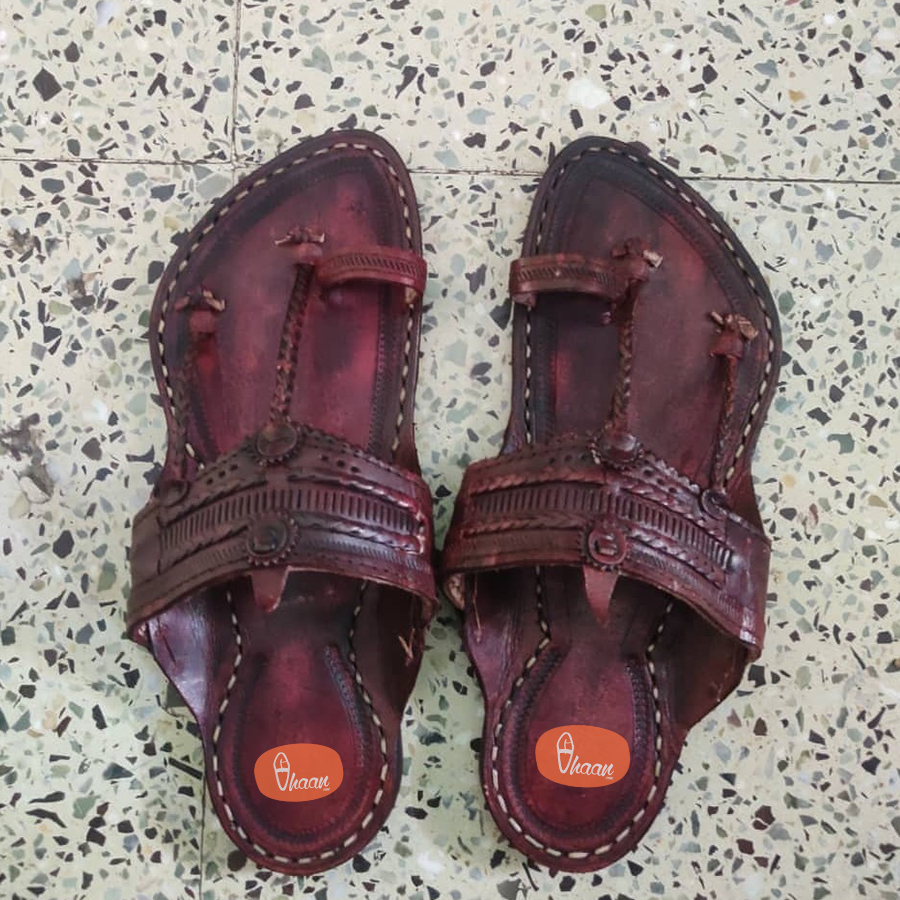The Kolhapuri chappal (footwear) is the world famous handcrafted footwear which was initially designed in the Kolhapur town of Maharashtra state in India. These handmade leather footwear are tanned by using vegetable dyes. The traditional designs of the Kolhapuri footwear are very famous not only in the rural areas of Maharasthra but also getting increasingly known across the globe. The Kolhapuri isn't limited to Kolhapur though, it is also referred by different names depending upon the place it was manufactured; places such as Kapashi, Paytaan, Kachkadi, Bakkalnali, and Pukari.
The Kolhapuri came into existence as early as the 13th century.
History has recorded that it was started and designed by the Saudagar family in 1920. The first model which was designed earlier was much thinner than what is available currently and was also known as "Chappal with ears" or "Kanwali" for it had two side flaps. The upper portion of the footwear was intricately designed.
By 18th century, it became very popular as "Kolhapuri".
When this model was sent to a retail store "J.J. and Sons" in South Mumbai, it was very much appreciated and further they ordered for another, then they ordered for another 20 more pairs and it was sold like hot cake in Bombay. Soon there was lot of demand for the Kanwalis in the market and so the Saudagar family extended their work by teaching the artistry to others. This footwear is known in local language as "Pie-taan". By 18th century it became very popular as Kolhapuri and soon after that it was also designed in adjoining towns and cities of Maharashtra.
The hand crafted Kolhapuris dyed with vegetable dyes initially came out to the market in the style of an open- toed and a T-strap sandal. It is processed by performing a series of mechanical or chemical operations in order to preserve it where the hides of buffalo are processed and grazed. As the leather is grazed it becomes hard enough and thereby durable and can be used for daily purpose. The original traditional Kolhapuris which was made using buffalo hide and thread had a thick sole and weighed to about 2 kgs and was able to withstand even high degree of heat and function properly in even hard mountain terrains. The traditional designs named after the place where it is made like, Kachkadi, bakkalnali, and pukari are noted for their special features like chunky, rugged appearance and durability. Very much suited for daily regular use, these footwear are available in vibrant colors, different sizes and patterns.
Kolhapuri Chappals are exquisitely designed and embellished.
The latest available models in the market are very intricately crafted with gold cord, zari strips, pom poms or gonda, etc., which can be even worn in occasions like weddings and parties giving it's owner a regal, royal look.
The Kolhapuris are not season specific and can be used both during winter and summer. The authentic Kolhapuri are usually handcrafted and made with pure leather. But there are other low qualities of fashionable Kolhapuris where a processed leather is used in the upper portion and the sole being made of rubber. Though not now, initially it was traded across the globe and it generated a big income to the state. The whole town of Kolhapur is mostly based on making of this footwear involving lot of artisans. Apart from the genuine Kolhapuri designs lot of similar patterns are also got from the neighboring states like Rajasthan and Gujarat. The specialty of the craftsmanship of the Indians is show-cased in this craft.
The financial constraints faced by the makers of the Kolhapuri.
Although the designs of these footwear are contemporary to the latest trend, they face difficulty fighting for their survival because of low sales and high end brands market. In spite of all the financial constraints faced by the makers of the Kolhapuris, one should be able to look into this as a pure Indian art which has to be nourished and preserved for they are just not footwear but a gift from our history. This is a highly attractive product and holds interest among the people which shows the dedication and the intrinsic work put in by the fellow craftsmen exhibiting the replica of both their culture and individuality. Apart from the major Kolhapuri variety there are other two types namely the Kapashi and Dongari. The original Kolhapuri is made from 100% cow or buffalo leather. It is mainly available in three colors: natural, oil and polish. The leather is processed in such a way were it gives a light, soft and silky feel and completely free from any allergic properties.
Stitching and punching is made by hand.
There are no nails or any other sharp thing used in this footwear. The stitching and punching is made with hand. Apart from the external beauty it gives the Kolhapuris, they do not cause any injury to the feet and adorn your feet with modern finesse and a regal look. There are no hard materials used in the manufacturing of these chappals. The making of the Kolhapuri is quite simple where two parallel piece of leather is joined and stitched with thin strings of leather or thongs, so that it gives us great comfort and is long-lasting. The Kolhapuris offer a wide range of variety from simple patterns to exquisite decorated patterns. The kolhapuris are enhanced with golden cords called "gota".
Making of the Kolhapuri Chappals
Initially during the ancient period, people used leaves and barks of the trees and various plants to protect their feet. This was slowly followed by the usage of animal skin. Then with modernization, different kinds of original and synthetic leathers were used. Originally the Kolhapuri footwear were made using Bog toning which was sourced from the medicinal plants like 'Hirada', 'Babul'. Being medicinal plants they imparted medicinal properties to the footwear which was an added advantage to the Kolhapuri footwear. These leathers by nature are
said to have small pores in it which absorb heat and thereby give a cooling effect to the feet and to the whole body.
Main factors which aided in crating a big demand for the Kolhapuris
The original Kolhapuri footwears are made from the hides of cow, goat and buffalo. These hides are processed through various steps and then grazed which ultimately makes the leather hard and durable and ideal for wear and tear. Once the leather is ready according to predesigned templates, the base is cut and based on the final requirement they are dyed with the above specified three colors. Then it goes for stitching where no nails are used and it is joined using only leather cords. Once this is done, the other enhancing adornments and embellishments are designed which results in the beautiful Kolhapuri's.
People still prefer the traditional Kolhapuris with modernization
There is also a young crowd which looks for the latest trend in the Kolhapuris. The original Kolhapuris had only certain specific hues of brown which ranged from a light tan to deeper reddish browns. But with updates in the latest trend we have come up with more brighter and vibrant shades. However, nothing competes with the traditional styles of Kolhapuri (check this out for example). It caters to all age groups like kids, girls, boys, men and women. In Pakistan, according to the latest trend the Kolhapuris are designed flat with fine work of gold and silver, and also beautiful laces and pan leather with different shades of brown and black. As changes keep coming in the entire field based on the latest trends, Kolhapuri's can be said that it is the only footwear which has remained static for ages for the changes are only maximized on the embroidery and the intricate work.
Changes are made in these footwear based on the culture
Changes based on culture of a particular region which sometimes even include colorful folk style. These footwear can pair themselves with a casual outfit as well as occasional party wear. The latest pattern of Kolhapuris are available in the branded Khaadis with bright colors ranging from violet to electric green, silver and golden colors. Added to the brilliant colors, they are also beautified by works like gota kinaari, stone work and delicate handwork. All these latest updates have given the Kolhapuri a modern outlook and versatility. Some of the famous patterns include Natural press palte, Char patti gents natural, Boot natural, Hare ram gents natural, Puda patent wa moje, Ladies panch silai kapsi moje, Ladies press palte brown, Ladies press palte natural and Yellow natural puda panted wa moje.
Kolhapuri are not limited to Kolhapur only.
Kolhapuri shoes and chappals are not only the favorite of the natives but also it is liked by people across the globe and thus have a great demand in the international market. They are not heavily priced and are mostly available in economical price. Even young entrepreneurs especially ladies have created lot of pages in the social network community like Facebook for these footwear. In spite of its fame throughout the country there is lot amiss about the Kolhapuris in the market for few authentic shop owners in the state say that the raw material has become very expensive by at least 50% which results in an increased cost of production. The other main drawback is that the Kolhapuri chappals have no patent protection. Hence there is lot of cheap imitation of the original Kolhapuri where the customers are not able to distinguish between the original and the duplicate. But still the manufacturers are able to trade these products both in the local and the international markets.
Cottage industry involved in making of the Kolhapuri footwear
Most of the industry involved in making of the Kolhapuri footwear is mainly cottage industries and the people belong to the cobbler community. These units generally employ some 5-10 labors; mostly the family members including the women of the house. Now in and around Kolhapur, there are about 5633 units engaged in the manufacture of Kolhapuri chappals employing 22500 artisans of which 10% are women artisans. The male workers undertake the job of cutting, seasoning of leather and fitting whereas the women workers carry the work of making upper belts designs and sole-stitching during the spare time. The export varieties of Kolhapuri footwear are mainly manufactured in Miraj, Jat and Kawathemahankal of Sangli district whereas fancy variety is mainly made in Kolhapur district.
Revenue from the export variety is estimated around INR 2 crores
The domestic market generates about INR 10 crores annually. Gramodyog Society Ltd. which is covered under the Maharashtra State Khadi Board, for whom finance for working capital to the extent of INR 10,000/- per craftsperson/unit @ 12% interest is arranged under the Page Scheme. Apart from this, few units working on large scale have been directly financed by Maharashtra Khadi and Village Industries Board to the extent of Rs.25, 000/- to Rs. 1, 00,000/- @ Rs.4% interest and 50% subsidy basis under D.R.I. scheme. Besides, the Mahatma Phule Backward Class Development Corporation Ltd. has also financed to the extent of Rs.25, 000/- @ Rs.4% interest and 50% subsidy for working capital, as needed. Depending upon the style and pattern the Kolhapuri footwear are priced very competitively where the minimum rate starts from Rs. 300 and crosses thousands
source : http://www.indianmirror.com/culture/indian-specialties/kolhapurifootwear.html


1 comment
vivek Gosavi
Nice information about history of kolhapuri Chappal Thank you for sharing.
I got wonderful experiences in kolhapuri chappal so i want share with you. i was wanted rich and latest designs kolhapuri chappal so i searching best kolhapuri chappal then i find KolGold Kolhapuri website. i order it . 2,3 days later i got that chappal. i was very happy seeing that chappal it was nice Kolpapuri Chappal Designs and looks. i think KolGold Kolhapuri is the best kolhapuri chappal websites.